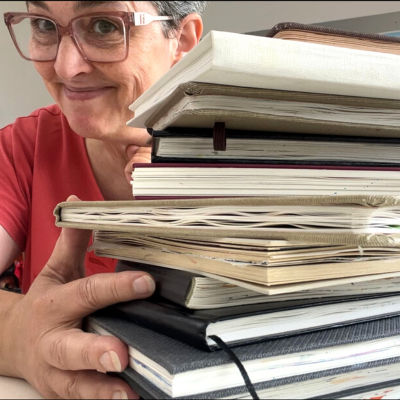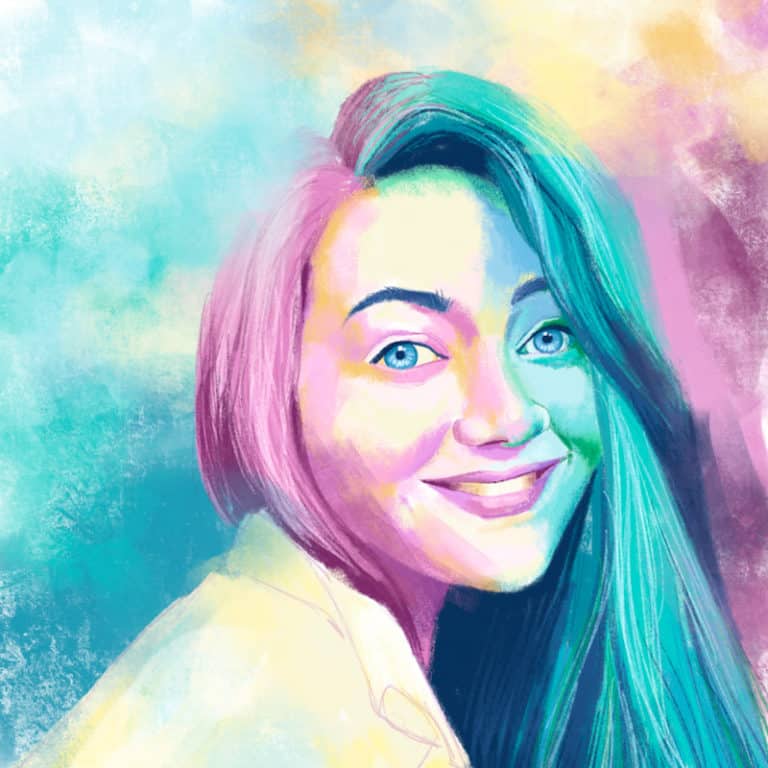How a Paris Fashion Exhibit Sparked My Most Playful Sketchbook Yet
At the end of March, I treated myself to a trip to Paris for my birthday—not just for cake and cafés (though, yes, those happened too), but for inspiration. I specifically planned this trip around visiting fashion exhibitions—something I’ve always found endlessly fascinating and creatively energizing.
Of all the shows I saw, the Dolce & Gabbana exhibition, Du Cœur à la Main (“From the Heart to the Hand”), made the biggest impression. It was dramatic, packed with gold, jewels, embroidery, texture, and story. Everything about it was completely over-the-top in the best way—so baroque and extravagant that it felt like walking through someone’s imagination made real. It was, quite honestly, too much. And I loved every second of it.
I didn’t go to Paris intending to start a new art project, but the idea came to life when I stumbled on a sketchbook with a beautiful Paris-themed cover. It felt like the perfect way to respond to the trip—not with a travel diary but a fashion-inspired creative journal. What followed was one of my most experimental, joyful sketchbook journeys.
Table of Contents
- Building Pages from Inspiration, Not Instruction
- When the Paper Fights You Back
- Sketchbook or Art Book?
- A Special Spread Inside the Membership
- Why It Was All Worth It
Building Pages from Inspiration, Not Instruction
This wasn’t a sketchbook with a plan. It wasn’t designed to become a course or be “shown” at first. That freedom gave me permission to use whatever I wanted—old supplies, weird textures, scraps I hadn’t touched in decades. It became this mixed media playground that leaned heavily into intuition.
The first few pages are full of gold experiments. I tested out gold materials to try and recreate the feeling of the ornate detailing from the exhibit. I glued in postcards from the exhibition, used a stamp that matched the baroque vibe, and layered in pieces of the event leaflets.
I even pulled out Gelli prints, lace, and bits of forgotten scrapbooking materials. One dress I recreated was made with tissue paper—scrunched and folded to mimic the flow of the actual garment. Another had layers of cut-out flowers from magazines, plus some glitter and stickers I’m not totally proud of (note to self: shiny stickers don’t always play nicely on camera).
There were no “rules.” If I had something in my stash, I tried it. If it looked a bit off, I kept going. The goal wasn’t a perfect spread—it was to play and see what happened. And sometimes, those are the best pages.

When the Paper Fights You Back
Let’s talk about the paper in this sketchbook for a minute.
At first glance, it looked perfect—soft texture, torn edges, vintage vibes. I was totally seduced by the aesthetic. But the reality? It’s awful to work with. The paper bleeds, drinks up ink like a sponge, and is so fragile that you can’t erase it without tearing it. It’s probably more suited for gluing in ticket stubs than for making actual art.
But funny enough, that limitation ended up pushing me into new directions. I had to layer differently, use more glue, think about how to back things with stronger paper, and mix materials to hide mistakes. It became a kind of puzzle—not ideal, but creatively energizing.
Because the paper wasn’t cooperating, I found myself drawing on separate sheets with alcohol markers, cutting them out, and gluing them in. I created one piece—a coat made with quilted fabric—from a Renaissance-inspired flyer, drew it on marker paper, and carefully layered it onto a black background to create contrast and drama. Those little problem-solving moments gave the sketchbook even more character.

Sketchbook or Art Book?
In the video, I mentioned that some people might say this isn’t a sketchbook. There are no rough sketches or scribbles—it’s all finished pages or at least intentional compositions. Maybe it’s more of an art journal or even an art book.
But I still call it a sketchbook because it feels like one. It holds my creative process, captures a moment in time, and reflects how I was experimenting and playing. It doesn’t need to be full of pencil roughs to qualify.
And for me—and many of the women in my art community—this kind of expressive, mixed-media process is precisely what sketchbooks are for. It’s about exploration, not obligation.

A Special Spread Inside the Membership
One of the pages I created in this sketchbook became the focus for this month’s gouache membership tutorial.
We break it down inside the membership step-by-step—from working with the reference image to layering shapes to getting that gold just right. You can join if you’d like to recreate that piece with me. And the best part? You get instant access to over 150 gouache tutorials when you sign up, along with live feedback, creative community support, and themed lessons every month.
The beginner-friendly membership is designed for women rediscovering (or just discovering!) their creative spark. You can join anytime and start where it feels right for you.

Why It Was All Worth It
The truth is, not every page in this sketchbook is a masterpiece. Some of them are clunky. Some didn’t work the way I hoped. But the process? It was joyful. Playful. Experimental. And that’s exactly what I needed.
Creating this sketchbook reminded me how important it is to make art just because it feels good—not to teach something or perfect a technique but to respond to beauty, memory, and the sheer delight of putting things together.
So if you’ve got a drawer of forgotten supplies, a few stickers from 2002, or a sketchbook with “bad paper” that’s been taunting you… maybe it’s time to open it. Use what you have. Follow a spark. And see where the pages take you.






